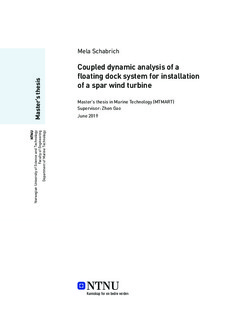| dc.description.abstract | A floating dock concept has been developed to assemble spar floating wind turbines near the offshore wind farm site. The concept comprises a floating dock that is moored on site with chains to the sea bed. The dock is shaped as a vertical tube giving space to install the wind turbines in its center and storing the components dryly on the top of its sides. It gives also space for cranes, living accommodation, offices and a landing platform.
The main motivation for this concept is that the turbines can be completed in the floating dock close to the site and not at a shipyard from where they have to be towed to the site.
At the time of the thesis, the conceptual design of the floating dock has already been validated and the dimensions have been optimized in regards to performance and cost. Also a series of model tests and a few numerical motion analyses have been separately performed. The purpose of this thesis is to establish a numerical model which coincide with the results of conducted model tests and to examine the behaviour of the dock in its operational mode.
Two different numerical modelling approaches are established. The hydrodynamic problem is hereby solved in WAMIT, a program that analyzes the interaction between ocean waves and offshore structures. Further modifications and simulations in time domain are run in SIMA, a workbench that analyses marine operations and floating systems. The results of the simulations, run under regular wave conditions, are compared and modified in regards to the model tests results. The comparison is hereby made based on the non-dimensional response amplitude operator (RAO) which is the transfer function between the wave amplitude and the dock motion.
The first approach turned out to be inadequate while the second approach proven to display reality sufficiently. So that in addition to the regular wave conditions, irregular wave conditions and decay tests are conducted for the second approach. Natural periods, power spectra, maximum motions and velocities are discussed and evaluated. Based on the evaluation, it can be concluded that with a modified mooring system the results should realistically describe the behaviour of the structure in its operational mode.
In closing, the most important points of the thesis are summed up and recommendations for future work are given. A recommendable next step is hereby certainly to replace the current mooring system, which is based on the mooring system of the model tests, with the mooring system of the actual dock. | |
